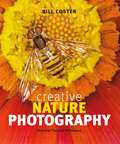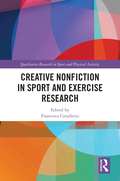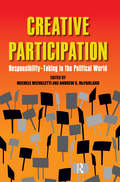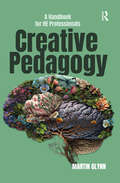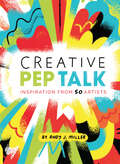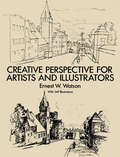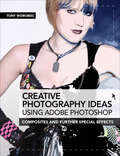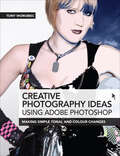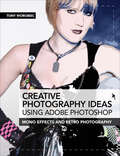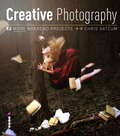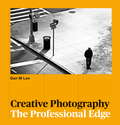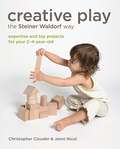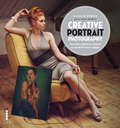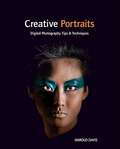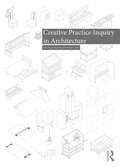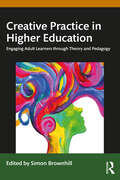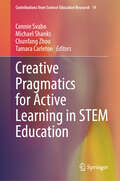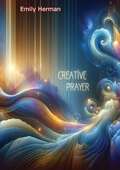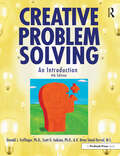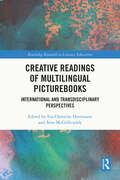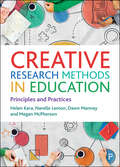- Table View
- List View
Creative Nature Photography
by Bill CosterAn indispensable guide to nature and outdoor photography, from the acclaimed author of Creative Bird Photography.This beautifully illustrated, inspirational guide to nature photography is packed with practical advice presented in author Bill Coster's informative but accessible writing style. It takes a fresh approach to the subject, breaking it up into chapters on habitats, each of which contains images of specific aspects of the environment, starting with landscapes and moving on to plants and animals. Each photograph demonstrates particular points and approaches, taking into account light conditions, terrain and the general surroundings. Fascinating anecdotes about Coster's experiences in each habitat bring the images to life. Each photograph is accompanied by detailed technical data, as well as information on locations and other issues that need to be tackled in order to achieve the perfect shot. There is also an up-to-date chapter on bird photography basics, including equipment such as cameras and lenses.
Creative Night
by Harold DavisTake a well-timed shot in the dark with this invaluable guide to night photographyShooting in low light and at night is challenging, but it can result in stunning images, so don't put that digital camera away after the sun goes down! Start capturing eerie and intriguing photographs at all levels of light with this information-packed guide from renowned photographer and author Harold Davis.He provides pages of field-tested techniques to help you find the proper exposures, including the best settings for ISO, aperture, and shutter. Don't miss the intriguing examples of his own work, including cityscapes, landscapes, and more.Walks readers through the intricacies of night and low light photography Explores the fundamental rules of exposure, including creative settings for ISO, aperture, and shutter speedsInforms and inspires with the author's own breathtaking examples of night photography, including cityscapes, landscapes, exciting night events, and other photos that illustrate the concepts Capture the visually exciting world after the sun goes down with this essential guide to night photography.
Creative Nonfiction in Sport and Exercise Research (Qualitative Research in Sport and Physical Activity)
by Francesca CavallerioAcademics around the world recognise the effectiveness of storytelling as a way to engage audiences in conversations, raising awareness of issues, and encouraging change. Stories are now seen as the best medium to convey information to diverse audiences. This book explores a novel approach to representing research findings through the adoption of creative nonfictional stories (CNF). At a time when dissemination of scientific research is constantly highlighted as a fundamental aspect for academics, CNF represents an opportunity to effectively communicate science to non-academic audiences through stories. By providing practical examples of how to transform findings into compelling stories rooted in data, following the mantra of showing rather than telling, which characterises CNF, Creative Nonfiction in Sport and Exercise Research helps researchers – qualitative, quantitative, established professors, and students – to turn their research into stories. A unique contribution to the field, this book is the first in the sport and exercise research field to take scholars on a discovery jouney, moving from their classic realist to a more creative, compelling, but still rigorous representation of research findings. The book features chapters written by authors from different sport research backgrounds, who present the findings of a previously published ‘classic’ study rewritten in the form of a story. Reflective chapters focusing on the how-to and the challenges of this creative analytical practice complete the work, to support scholars in developing their creative skills.
Creative Participation: Responsibility-Taking in the Political World
by Michele Micheletti Andrew S. McFarlandCreative Participation presents the theory and practice of new innovative forms of political participation. Examples covered in the book include consumers engaging in political shopping, capitalists building green developments, UK Muslim youth campaigning on the internet, Sicilian housewives taking on the Mafia, young evangelical ministers becoming concerned with social change and vegetarians making political statements. The authors show how in these new campaigns individuals swarm like honeybees around particular issues, causing those in power to sit up and take notice. This is the essential guide to the new politics of participation.
Creative Pedagogy: A Handbook for HE Professionals
by Martin GlynnThe ultimate toolkit for lecturers and practitioners in higher education aimed at developing creative pedagogy that will inspire and empower students. It demonstrates how creative teaching and learning methods can engage students and encourage them to be reflective and mindful, as well as enhancing their potential to build social and cultural capital, increase their employability prospects, social mobility and civic participation.It recognises that traditional teaching methods do not work for all learners and embraces contemporary ideas, innovative strategies and new technologies that can provide appropriate and accessible learning for students, enabling HE lecturers to challenge the status quo and expand their creative teaching skillset. Learning can become a co-construction between the lecturer and students with outcomes of increased retention in the classroom, more engagement in the learning, and more fun. This could be the start of doing things not only differently but more effectively.
Creative Pep Talk: Inspiration from 50 Artists
by Andy J. MillerEvery artist needs a little pep talk now and then. An inspiring tool and beautiful art book in one, Creative Pep Talk offers illustrated words of wisdom from 50 of today's leading creative professionals. With full-color, typographic prints and explanatory statements from a host of creative luminaries—including Aaron James Draplin, Oliver Jeffers, Lisa Congdon, Mike Perry, and many others—this volume encourages artists to stay excited, experiment boldly, and conquer fear. "Create curiosity," "Learn to say no," and "If you can't be good, be different" are just a few of the motivational maxims in this visually rich collection that's perfect for students, designers, artists, and creatives at any stage in their careers.
Creative Perspective for Artists and Illustrators (Dover Art Instruction)
by Ernest W. WatsonIn this thought-provoking practical guide, a noted artist and educator demonstrates that learning to violate the rules of perspective (profitably) is as important for the practicing artist as learning the principles of perspective themselves. Only in this way can students free themselves from the constraints of tradition and find their own imaginative paths. However, it is vital that students first have a solid grasp of classical perspective before they can think about adapting it creatively.In presenting the principles of perspective drawing, Mr. Watson devotes a chapter each to step-by-step discussions of such topics as the picture plane, foreshortening and convergence, the circle, the cone, three-point perspective, universal perspective, figures in perspective, and much more. To illustrate his points he offers expert analysis of the works of such leading illustrators as John Atherton, V. Bobri, R. M. Chapin, Jr., Albert Dorne, Robert Fawcett, Constantin Guys, W. N. Hudson, Carl Roberts, Ben Stahl, and Aldren A. Watson, as well as drawings by Pieter de Hooch and Paul Cézanne. The result is a ground-breaking study that artists, illustrators, and draftsmen will find invaluable in learning to create works with convincing perspective.Ernest W. Watson taught at Pratt Institute for over 20 years, co-founded and served as editor-in-chief of the magazine American Artist, and co-founded the prestigious art publishing house of Watson-Guptill.
Creative Photography Ideas: Composites and Further Special Effects
by Tony WorobiecComposites and further special effects is an excerpt from Creative Photography Ideas Using Photoshop which presents 75 comprehensive workshops that have been specifically designed for photographers; each offers a clever and creative technique that can be immediately applied.Composites and further special effects workshops focus specifically on creating composites; from dropping in a sky to producing sunbeams, using multiple files, blending mode, refine edge, the gradient tool, multiple layers. There are plenty of creative ideas that will take your photography that little bit further from creating a 'joiner' or 'still movie' to joining two landscapes and creating a mirror image.Each workshop offers ingenious creative techniques to immediately enhance images in Adobe Photoshop.From basic techniques to more advanced, all guidance is ‘best practice’ and shown via clear explanatory texts, photographs, ‘before, during and after’ manipulations and screen grabs.
Creative Photography Ideas: Making Simple Tonal and Colour Changes
by Tony WorobiecIn-computer editing is now as important as in-camera shooting; this book provides ingenious creative techniques to immediately enhance images through this medium.Presents 75 comprehensive workshops that have been specifically designed for photographers; each offers a clever and creative technique that can be immediately applied.Takes a specific, unique slant to provide a wide range of creative tips and tricks designed to appeal primarily to photographers, but also to other ‘creatives’ using the programme.From basic techniques to more advanced, all guidance is ‘best practice’ and shown via clear explanatory texts, photos, ‘before, during and after’ manipulations and screen grabs.
Creative Photography Ideas: Mono Effects and Retro Photography
by Tony WorobiecMono effects and retro photography is an excerpt from Creative Photography Ideas Using Photoshop which presents 75 comprehensive workshops that have been specifically designed for photographers; each offers a clever and creative technique that can be immediately applied.Mono effects and retro photography workshops focus specifically on mono effects such as sepia toning, lith effects, and selective colouring, as well as creating retro photography effects such as pinhole camera, adding borders, and disressing images.Each workshop offers ingenious creative techniques to immediately enhance images in Adobe Photoshop.From basic techniques to more advanced, all guidance is ‘best practice’ and shown via clear explanatory texts, photographs, ‘before, during and after’ manipulations and screen grabs.
Creative Photography: 52 More Weekend Projects
by Chris GatcumExperiment with new projects and techniques, and create arresting images time and again Digital cameras have made it easy for us all to take photos that are, technically, perfect: clearly exposed, sharply focused, and beautifully composed. However, what most photographers want from their photography is something more personal, more individual - in short, more creative. In this sequel to the highly successful Creative Digital Photography: 52 Weekend Projects, respected author and prize-winning photographer Chris Gatcum will show you how to create images that pack that creative punch and involve fun.
Creative Photography: The Professional Edge
by Adam Juniper Dan LeeTo earn a living these days, your photography has to rise above a lot of noise, so you need all the advantages you can get. Here, Dan M. Lee gives you back-to-back hard-hitting ideas that are proven to make every shot in your portfolio a stand-out image that grabs attention and wins new clients.Clients recognize and reward creativity. It's not enough to be competent with a camera: you need to experiment, find new perspectives, and innovate your workflow if you want to stay competitive. Whether that's using drones for aerial viewpoints, or creating perfect 360-degree real-estate images, this book gives you the edge you need to make it as a professional photographer.
Creative Play the Steiner Waldorf Way: Expertise and toy projects for your 2-4-year-old
by Janni Nicol Christopher ClouderCreative Play the Steiner Waldorf Way is the ideal book for parents who want their children to develop their creativity and imagination through play. It teaches you how to let your child develop according to the Steiner theory, which helps children to fulfil themselves naturally and holistically in mind, body and spirit. Each chapter covers a different element of your child's development and includes an expert summary of Steiner theory and how it relates to children and parents today. You will find instructions for how to make over 20 beautiful toys from natural materials to encourage your child to develop creativity, awareness, confidence and imagination.
Creative Portrait Photography: Innovative Digital Portraiture To Reveal The Inner Subject
by Natalie DybiszThe very best portrait photography strives to give the viewer access into their subject's inner self; to provide a window into their soul. With the advent of the digital age and the potential afforded by post-processing, a whole generation of photographic artists has access to greater creative possibilities than ever before.Spearheading this new breed of creative photographer is author Natalie Dybisz, better known in the photographic community as Miss Aniela. Devoted to exploring portraiture at its most creative portraits with context, story, and constructed elements Creative Portrait Photography takes the reader on a behind-the-scenes journey through the creation of Natalie Dybisz's innovative digital portraits, from first concept to post-processing.Also featuring an extensive showcase chapter in which other photographer-artist's work and working methods are laid bare, Creative Portrait Photography has everything you need to inspire you and transform your perspective on portrait photography.
Creative Portraits
by Harold DavisGo beyond the basic rules of photography to capture stunning portraitsPortrait photography is a vital topic for photographers of every level of experience, from amateur to professional. Written by renowned photographer Harold Davis, this inspirational book encourages you to define our own photographic style and capture stunning, creative, and unique portraits.You'll discover tips and techniques for "breaking the rules" of basic digital photography so that you can go beyond the fundamentals such as composition, lighting, and exposure in order to create memorable and incomparable portraits.Explores the most common subject of most photographers-people-and explains when, why, and how to forgo the fundamentals to capture memorable portraitsEncourages you to define your own unique photographic style and offers information and inspiration to help you do soDelves into a variety of creative techniques that you can use when exploring ways to take lively and stunning portraitsIllustrated with Harold Davis's striking portrait photography, Creative Portraits will both inform and inspire you.
Creative Power: The Nature And Nurture Of Children's Writing
by Ronald L. CramerThis accessible book examines the nature of children's writing, and helps teachers discover how to best nurture in children's creative potential. A thorough explanation of the practices and strategies needed to understand young writers and their writing, the book provides a wealth of information and ideas about the language, interests, and creative capabilities of today's children. Strong pedagogy offers explicit, practical examples with direct application to instruction. Each chapter begins with a brief vignette that captures the drama and excitement of becoming a writer. Boxed features summarize the best approaches to putting instructional concepts and strategies into practice. For Elementary English Teachers.
Creative Practice Inquiry in Architecture
by Adam Sharr Ashley MasonThis collection introduces, illustrates, and advances fresh ideas about creative practice inquiry in architecture. It concerns architectural knowledge: how architects can use their distinctive skills, habits, and values to advance professional insight, and how such insights can be extended to make wider contributions to society, culture, and scholarship. It shows how architectural ways of knowing and working can be mobilised as tools for research. Collected here are a series of creative practices that emerge out of architecture and actively engage with other fields and methods reaching across the academic landscape. Architectural inquiries collected in this book probe matters that lie beyond the obvious expectations, the conventions, the default, of the discipline. Drawing, borrowing, adapting, dramatising, perhapsing, monstering, experimenting, cartooning—the tools and methods of each inquiry vary but they all share a common outward gaze, engaging architectural ways of knowing with other disciplines and practices including the arts, biological sciences, ethnography, and technology. Chapters gathered here offer insight not only into incipient modes and tools of architectural research, but emerging ethical, practical, and philosophical positions intimately tied to the creative practices involved. Setting-out the idea of creative practice inquiry in architecture, this innovative volume offers a lively and resourceful contribution to a growing body of work on design as research. It will be of interest to: students keen to pursue architectural ways of thinking and writing; practitioners who want to use their distinctive professional abilities to contribute to architectural and scholarly knowledge; and academics and doctoral candidates keen to engage with the burgeoning scholarly field of design research.
Creative Practice in Higher Education: Engaging Adult Learners through Theory and Pedagogy
by Simon BrownhillThis must-read book considers the ways in which creativity can inspire new ideas, invigorate teaching in the adult learning space, and motivate professionals and learners alike. Written by a diverse group of international collaborators, this book empowers readers to embrace creative practices that are considered innovative, engaging, and impactful for adult learners at different levels.Drawing from a range of theoretical perspectives, contemporary research, and the lived experiences of the contributing authors, this edited volume offers readers a rich collection of pedagogical ideas and practical examples to apply within their professional practice. Chapters are divided into three key sections: Engaging experiences, such as large lectures, learning beyond the classroom, innovative technologies, and creative approaches to self-reflection. Engaging groups, including an exploration of communities within a range of educational, research, and geographical contexts. Engaging tools for learning, for example, poetry, digital portfolios, and innovations in providing feedback. An essential read for anyone working in adult education, this book highlights how practitioners may engage adult learners in creative ways within universities, with implications for further education and other adult education institutions.
Creative Pragmatics for Active Learning in STEM Education (Contributions from Science Education Research #14)
by Michael Shanks Tamara Carleton Connie Svabo Chunfang ZhouThis edited volume is an invitation to redesign STEM higher education. It shows the way to active learning in diverse scenarios and provides educators, leaders and policymakers with a visionary approach to active learning and hands-on examples of how education can help students navigate complexity and unpredictability—the challenges of contemporary society. Featuring contributions from a diverse array of scholars and practitioners, this book explores: · Creative learning strategies · Dynamic teacher-student interactions <span style="mso-bidi-font-size
Creative Prayer
by Emily HermanDiscover the transformative power of prayer with Emily Herman's Creative Prayer. This insightful and inspiring work explores the dynamic and creative aspects of prayer, offering readers a profound understanding of how prayer can be a vibrant and enriching part of their spiritual lives.Emily Herman, a respected author and spiritual teacher, delves into the essence of prayer, presenting it not just as a routine practice but as a powerful tool for personal and spiritual growth. In Creative Prayer, Herman encourages readers to explore prayer as a creative act that can deepen their connection with the divine, enhance their spiritual awareness, and bring about positive change in their lives.The book provides practical guidance on how to cultivate a more meaningful and engaging prayer life. Herman explores various forms of prayer, including contemplative, intercessory, and expressive prayers, and offers insights into how each type can be adapted to suit individual needs and circumstances. She emphasizes the importance of authenticity and spontaneity in prayer, encouraging readers to approach prayer with an open heart and a creative spirit.Creative Prayer also addresses common challenges and obstacles to effective prayer, providing strategies for overcoming distractions, doubts, and feelings of spiritual dryness. Herman’s compassionate and supportive approach helps readers navigate these challenges and find new ways to connect with the divine presence in their everyday lives.Rich with personal anecdotes, spiritual wisdom, and practical exercises, Creative Prayer is a valuable resource for anyone seeking to deepen their prayer practice and experience the transformative power of prayer. Whether you are new to prayer or looking to reinvigorate your existing practice, this book offers inspiration and guidance for making prayer a dynamic and life-enhancing part of your spiritual journey.
Creative Problem Solving in School Mathematics
by George LenchnerSolutions to part c Problems Some problem solving Strategies Some Topics in Problem Solving Solutions to Part a Problems Solutions to Part b Problems Teaching Problem Solving
Creative Problem Solving: An Introduction
by Donald J. Treffinger Scott G. Isaksen K. Brian Stead-DorvalCreative Problem Solving is a process that allows people to apply both creative and critical thinking to find solutions to everyday problems. Creative Problem Solving eliminates the tendency to approach problems in a haphazard manner and, consequently, prevents surprises and/or disappointment with the solution.Used by thousands of group leaders seeking a friendly introduction to using Creative Problem Solving, this book is a time-honored classic. Creative Problem Solving: An Introduction is based on more than five decades of extensive research, development, and field experience in educational settings, businesses, and many other organizations.Written for both group leaders and individuals seeking a systematic way to build innovative and effective solutions, Creative Problem Solving is perfect for any type of setting.This definitive guide shows you how to find successful solutions to important challenges. Creative Problem Solving (CPS) can help your students to approach problems and deal with change in a deliberate and constructive way, building their confidence and success in working with complex issues.This revised and updated fourth edition includes: easy-to-follow instructions for using Creative Problem Solving; practical tools for understanding the challenge, generating ideas, and preparing for action; expanded guidelines for planning your approach to Creative Problem Solving; strategies that ensure successful group dynamics; the latest trends in creative thinking and group problem solving; and practical suggestions for those new to Creative Problem Solving.Educational Resource
Creative Provocations: Speculations on the Future of Creativity, Technology & Learning (Creativity Theory and Action in Education #7)
by Danah Henriksen Punya MishraThis book explores the complex, yet critical, relationship between technology and creativity, specifically in educational contexts. Creativity is important for success in today’s rapidly changing, radically contingent and hyperconnected world. This is even more relevant in the context of teaching and learning—where the psychological, sociological and cultural aspects of human learning confront the challenges of a rapidly changing, technologically saturated world. Written by some of the foremost thinkers and researchers in the area of creativity and/or technology, the chapters in this volume examine the impact of recent and future technologies on creativity, teaching and learning. Individually and collectively, they help us develop an understanding of this nexus of creativity and technology for education. They offer new perspectives on this rapidly evolving future—exploring issues, paradoxes, tensions, and points of interest for creativity and technology. They position these issues in ways that consider implications for thinking, learning, teaching, and education in general.
Creative Readings of Multilingual Picturebooks: International and Transdisciplinary Perspectives (Routledge Research in Literacy Education)
by Áine McGillicuddy Esa Christine HartmannThis edited volume offers fresh perspectives on linguistic and cultural diversity in multilingual picturebooks, examining their potential to support multilingual learning in different educational contexts. Drawing on international, transdisciplinary perspectives from over fifteen countries, the book provides a comprehensive view of this unique literary genre.The collection showcases a wide range of languages featured in multilingual picturebooks, including Chinese, Farsi, Georgian, Irish, Korean, Malagasy, Mexican Indigenous languages, Mirandese, Northern Sámi, Portuguese, Spanish, Te Reo Māori, Ukrainian, and Welsh. Various chapters examine how multilingual picturebooks foster language and literacy development for emergent bilinguals in multilingual and multicultural environments, highlighting benefits such as linguistic and semiotic code-switching, as well as their ability to stimulate intercultural awareness in readers. The book also considers the creation, translation, and complex publishing processes of multilingual picturebooks, while exploring modern technologies such as eye tracking to analyse the reading processes of these books.Reflecting current insights and innovations in picturebook research, this volume will appeal to scholars, academics, and researchers in language and literacy education, multilingual education, and early childhood education. Those involved in children’s literature studies, multimodality, and bilingualism more broadly will also find this collection valuable.
Creative Research Methods in Education: Principles and Practices
by Helen Kara Narelle LemonCo-authored by an international team of experts across disciplines, this important book is one of the first to demonstrate the enormous benefit creative methods offer for education research. You do not have to be an artist to be creative, and the book encourages students, researchers and practitioners to discover and consider new ways to explore the field of education. It illustrates how using creative methods, such as poetic inquiry, comics, theatre and animation, can support learning and illuminate participation and engagement. Bridging academia and practice, the book offers: • practical advice and tips on how to use creative methods in education research; • numerous case studies from around the world providing real-life examples of creative research methods in education practice; • reflective discussion questions to support learning.
